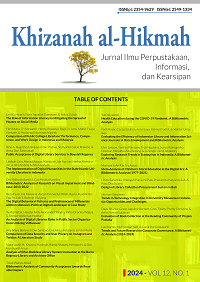Analysis of Elfan Bookless Library System Innovation at the Barru Regency Library and Archives Office
Abstract
This qualitative study explores the innovation of the Elfan Bookless Library System at the Barru Regency Library and Archives Office. Data were collected through observation, interviews, and documentation, with validity ensured via triangulation, negative case analysis, member checking, and extended observations. The findings reveal that the Elfan Bookless Library System enhances the reading experience by providing its own Wi-Fi network, allowing online book access. While the system effectively meets visitors' needs, its Wi-Fi coverage is limited to 500 meters, posing a connectivity challenge beyond this range. Despite this, the system is accessible without special requirements; visitors only need a cellphone or Android device. User guidance is provided through tutorials on billboards and banners, and library staff offers additional support. This study highlights the Elfan Bookless Library System's potential to innovate public library services, offering valuable insights into its advantages and limitations. These findings contribute to understanding how digital library systems can be optimized to improve user experience and accessibility in public libraries.
Downloads
References
Anser, M. K., Tabash, M. I., Nassani, A. A., Aldakhil, A. M., & Yousaf, Z. (2023). Toward the e-loyalty of digital library users: investigating the role of e-service quality and e-trust in digital economy. Library Hi Tech, 41(4). https://doi.org/10.1108/LHT-07-2020-0165
Bircan, İ., & Gençler, F. (2015). Analysis of Innovation-Based Human Resources for Sustainable Development. Procedia - Social and Behavioral Sciences, 195, 1348–1354. https://doi.org/https://doi.org/10.1016/j.sbspro.2015.06.321
Cavalcante, P., & Camões, M. (2017). Do the Brazilian innovations in public management constitute a new model? RAI Revista de Administração e Inovação, 14(1), 90–96. https://doi.org/https://doi.org/10.1016/j.rai.2016.07.001
Chen, J., Walker, R. M., & Sawhney, M. (2020). Public service innovation: a typology. Public Management Review, 22(11). https://doi.org/10.1080/14719037.2019.1645874
Choudhury, V., & Karahanna, E. (2008). The relative advantage of electronic channels: A multidimensional view. MIS Quarterly: Management Information Systems, 32(1). https://doi.org/10.2307/25148833
Government Regulation of the Republic of Indonesia Number 24 of 2014 Concerning the Implementation of Law Number 23 of 2007 Concerning Libraries. Peraturan Pemerintah Republik Indonesia Nomor 24 Tahun 2014 Tentang Pelaksanaan Undang-Undang Nomor 23 Tahun 2007 Tentang Perpustakaan., (2014).
Hong, S. G., & Lee, D. H. (2023). Development of a citizen participation public service innovation model based on smart governance. Service Business, Vol. 17. https://doi.org/10.1007/s11628-023-00536-w
Hutagalung, S. S., & Hermawan, D. (2018). Membangun Inovasi Pemerintah Daerah. In Deepublish (1st ed.). Yogjakarta.
Instruction of the President of the Republic of Indonesia Number 3 of 2003 regarding National Policy and Strategy for the Development of Electronic Government. Instruksi Presiden Republik Indonesia Nomor 3 Tahun 2003 Tentang Kebijakan Dan Strategi Nasional Pengembangan Pemerintahan Secara Elektronik., (2003).
Ismail, I., & Darwis, M. (2016). Efektivitas Pelayanan Perpustakaan Sekolah Bagi Siswa di SMK Negeri 1 Pare-Pare. Jurnal Office, 2(2), 215–220.
Junglas, I., Goel, L., Ives, B., & Harris, J. (2019). Innovation at work: The relative advantage of using consumer IT in the workplace. Information Systems Journal, 29(2). https://doi.org/10.1111/isj.12198
Kuhar, M., & Merčun, T. (2022). Exploring user experience in digital libraries through questionnaires and eye-tracking data. Library and Information Science Research, 44(3). https://doi.org/10.1016/j.lisr.2022.101175
Leckel, A., Veilleux, S., & Dana, L. P. (2020). Local Open Innovation: A means for public policy to increase collaboration for innovation in SMEs. Technological Forecasting and Social Change, 153. https://doi.org/10.1016/j.techfore.2019.119891
Mellinia, A., & Hadiapurwa, A. (2023). Pemanfaatan Edoo Sebagai Bentuk Inovasi Layanan Di Perpustakaan Sman 15 Bandung. Jurnal Ilmu Informasi Perpustakaan Dan Kearsipan, 11(02), 139–142.
Mombeuil, C., & Uhde, H. (2021). Relative convenience, relative advantage, perceived security, perceived privacy, and continuous use intention of China’s WeChat Pay: A mixed-method two-phase design study. Journal of Retailing and Consumer Services, 59. https://doi.org/10.1016/j.jretconser.2020.102384
Niswaty, R., Darwis, M., Andriani, D., Nasrullah, M., & Salam, R. (2020). Fasilitas Perpustakaan Sebagai Media dalam Meningkatkan Minat Baca Siswa. Khizanah Al-Hikmah: Jurnal Ilmu Perpustakaan, Informasi, Dan Kearsipan, 8(1), 71–78.
Presidential Regulation of the Republic of Indonesia Number 59 of 2017 Concerning the Implementation of Achieving Sustainable Development Goals. Peraturan Presiden Republik Indonesia Nomor 59 Tahun 2017 Tentang Pelaksanaan Pencapaian Tujuan Pembangunan Berkelanjutan., (2017).
Rosman, M. R. M., Ismail, M. N., & Masrek, M. N. (2020). Investigating the predictors of digital library engagement: A structured literature analysis. Pakistan Journal of Information Management and Libraries, 22. https://doi.org/10.47657/1586
Syarifuddin, H. M., Tahir, H., Akib, H., & Rusdi, M. (2021). Innovation of Electronic Licensing Information System at the Office of Investment and One Stop Integrated Services (DPMPTSP) of Bone Regency. Jurnal Office, 7(1), 169–182.
The Global Innovation Index (GII). (2023). Ranks World Economies According to Their Innovation Capabilities.
Yu, J., Jin, J., Chen, F., & Zhang, Y. (2023). Digital-Enabled Public Service Innovation in China’s eHealth Sector: An Institutional Logics Perspective. IEEE Transactions on Engineering Management, 70(4). https://doi.org/10.1109/TEM.2020.3005767
Copyright (c) 2024 Nasaruddin H., Khusnul Hatimah, Risma Niswaty, Herman H, Sitti Hardiyanti Arhas

This work is licensed under a Creative Commons Attribution-NonCommercial-ShareAlike 4.0 International License.
By submitting your manuscript to our journal, you are following Copyright and License

